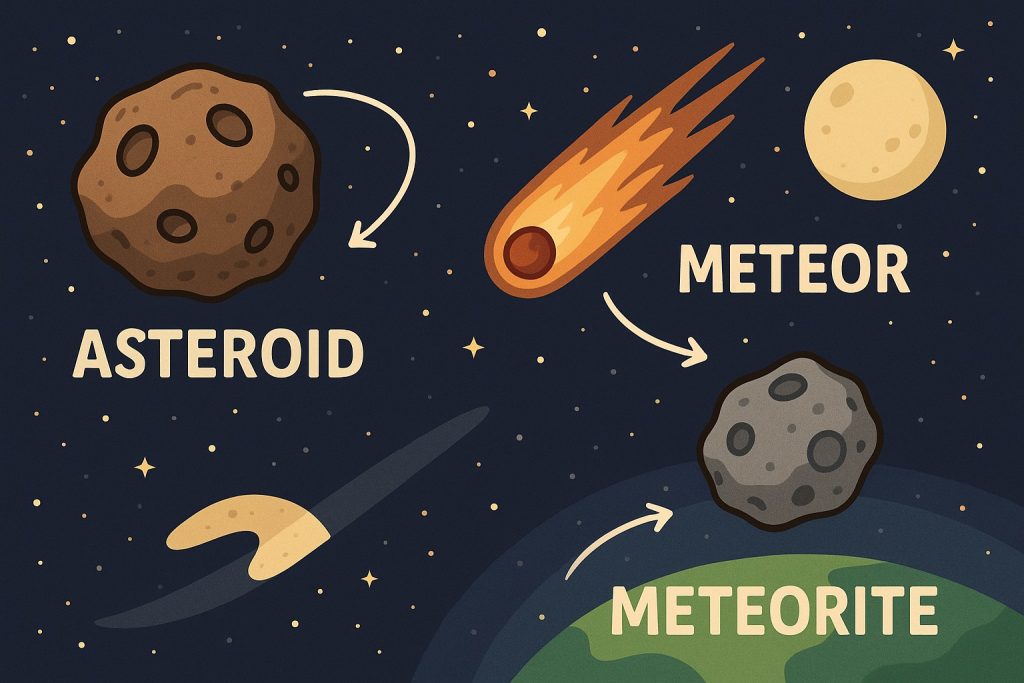Asteroids and meteorites are rocky fragments from space that offer a window into the early history of the Solar System. While they are often confused or used interchangeably, these cosmic objects are part of a larger group of space debris that can range from harmless dust to planet-destroying giants. In this article, we’ll explore what asteroids and meteorites are, how they differ, and why they’re important for science — and sometimes, for planetary safety.
What Are Asteroids?
Asteroids are rocky bodies that orbit the Sun, mostly found in the asteroid belt between Mars and Jupiter. They vary in size from a few meters to hundreds of kilometers wide.
Key Facts:
- Made of rock, metal, or a mix of both
- Have no atmosphere, moons, or light of their own
- Thousands are tracked by space agencies due to their collision potential with Earth
- Some are classified as Near-Earth Objects (NEOs) if their orbits come close to our planet
What Are Meteorites?
Meteorites are fragments of asteroids (or sometimes comets) that survive their journey through Earth’s atmosphere and land on the ground.
Related Terms:
- Meteoroid – a small space rock, often asteroid debris, traveling through space
- Meteor – the bright flash or “shooting star” seen when a meteoroid burns in Earth’s atmosphere
- Meteorite – what remains if part of the object reaches the Earth’s surface
Meteorites can be small as pebbles or weigh tons and are often collected for scientific study.
What Are They Made Of?
Asteroids:
- C-type (carbonaceous): contain clay, silicates, and organic molecules
- S-type (silicaceous): made mostly of silicate rock and metal
- M-type (metallic): rich in iron and nickel
Meteorites:
- Stony: most common; made of silicate minerals
- Iron: mostly metallic; very dense
- Stony-iron: rare and mixed composition
Famous Impacts and Discoveries
- Chicxulub Impact (66 million years ago): Likely caused the extinction of the dinosaurs
- Tunguska Event (1908): A large airburst over Siberia flattened 2,000 km² of forest
- Chelyabinsk Meteor (2013): Exploded over Russia, injuring 1,500 people from shockwaves
Meteorites have been found on every continent — even Antarctica — and are used to study the Solar System’s origins.
Scientific Importance
- Asteroids and meteorites are primitive — unchanged since the Solar System’s formation
- Provide clues about early planetary materials, including water and organic compounds
- Help scientists understand the risks and probabilities of future impacts
- Some are targeted for space mining due to their rare metals and minerals
Are They Dangerous?
Most meteoroids that enter Earth’s atmosphere burn up harmlessly. But large asteroids could cause regional or global disasters.
To protect Earth:
- NASA and other agencies track thousands of NEOs
- The DART mission (2022) successfully demonstrated asteroid redirection
- Emergency plans exist for impact warnings in the future
Conclusion
Asteroids and meteorites are cosmic leftovers that help us understand both the past and potential future of Earth. While most are harmless, the possibility of an impact keeps them in the spotlight of planetary science and defense. At the same time, meteorites offer rare, tangible pieces of space that we can study right here on Earth.
Glossary
- Asteroid – a rocky object orbiting the Sun, usually between Mars and Jupiter
- Meteoroid – a small space rock moving through space
- Meteor – a bright flash seen when a meteoroid enters Earth’s atmosphere
- Meteorite – a piece of a meteoroid that survives and lands on Earth
- NEO (Near-Earth Object) – an asteroid or comet that comes close to Earth’s orbit


